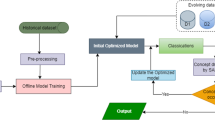Abstract
Machine learning models assume that data is drawn from a stationary distribution. However, in practice, challenges are imposed on models that need to make sense of fast-evolving data streams, where the content of data is changing and evolving over time. This change between the distributions of training data seen so-far and the distribution of newly coming data is called concept drift. It is of utmost importance to detect concept drifts to maintain the accuracy and reliability of online classifiers. Reactive drift detectors monitor the performance of the underlying machine learning model. That is, to detect a drift, feedback on the classifier output has to be given to the drift detector, known as prequential evaluation. In many real-life scenarios, immediate feedback on classifier output is not possible. Thus, drift detection is delayed and gets out of context. Moreover, the drift detector output is in the form of a binary answer if there is a drift or not. However, it is equally important to explain the source of drift. In this paper, we present the Statistical Drift Detection Method (SDDM) which can detect drifts by monitoring the change of data distribution without the need for feedback on classifier output. Moreover, the detection is quantified and the source of drift is identified. We empirically evaluate our method against the state-of-the-art on both synthetic and real life data sets. SDDM outperforms other related approaches by producing a smaller number of false positives and false negatives.











Similar content being viewed by others
Notes
Noise refers to random changes in features’ values that are not caused by a concept drift.
References
Baena-Garcıa, M, & et al. (2006). Early drift detection method. Fourth international workshop on knowledge discovery from data streams, 6.
Barros, R.S., Cabral, D.R., Santos, S.G., & et al. (2017). RDDM: reactive drift detection method. Expert Systems with Applications.
Bifet, A., & Gavalda, R. (2007). Learning from time-changing data with adaptive windowing. SIAM Society for Industrial and Applied Mathematics.
Bifet, A., & et al. (2009). New ensemble methods for evolving data streams. SIGKDD ACM.
Bifet, A., & et al. (2010). Moa: massive online analysis. Journal of Machine Learning Research, 11, 1601–1604.
Doshi-Velez, F, & Kim, B. (2017). Towards a rigorous science of interpretable machine learning. arXiv:1702.08608.
Duda, R.O., Hart, P.E., & Stork, D.G. (2001). Pattern classification, (p. 680). New York: Wiley.
Frías-Blanco, I., & et al. (2015). Online and non-parametric drift detection methods based on Hoeffding’s bounds. IEEE TKDE, 27.3, 810–823.
Gama, J, & et al. (2004). Learning with drift detection. Brazilian symposium on artificial intelligence. Springer.
Gama, J, & et al. (2014). A survey on concept drift adaptation. ACM Computing Surveys (CSUR), 46.4, 44.
Hoens, T.R., Chawla, V, & Polikar, R. (2011). Heuristic updatable weighted random subspaces for non-stationary environments. ICDM. IEEE.
Huang, D.T.J., & et al. (2015). Drift detection using stream volatility. ECML PKDD. Springer.
Kubat, M., & Widmer, G. (1995). Adapting to drift in continuous domains. ECML Springer.
Kullback, S., & Leibler, R.A. (1951). On information and sufficiency. The Annals of Mathematical Statistics, 22.1, 79–86.
Kuncheva, L.I. (2004). Classifier ensembles for changing environments. International Workshop on Multiple Classifier Systems. Springer.
Levin, D.A., & Peres, Y. (2017). Markov chains and mixing times (Vol. 107). American Mathematical Soc.
Manning, C., Raghavan, P., & Schütze, H. (2010). Introduction to information retrieval. Natural Language Engineering, 16.1, 100–103.
Mishihara, R., Moritz, P., Wang, S., Tumanov, A., Paul, W., Schleier-Smith, J., Liaw, R., Niknami, M., Jordan, M.I., & Stoica, I. (2017). Real-time machine learning: the missing pieces. HotOS, 106–110.
Olorunnimbe, M.K., Viktor, H.L., & Paquet, E. (2018). Dynamic adaptation of online ensembles for drifting data streams. Journal of Intelligent Information Systems, 50.2, 291–313.
Page, E.S. (1954). Continuous inspection schemes. Biometrika, 41 (1/2), 100–115.
Pesaranghader, A, & Viktor, H.L. (2016). Fast hoeffding drift detection method for evolving data streams. ECML PKDD. Springer.
Pesaranghader, A, Viktor, H.L., & Paquet, E. (2018). McDiarmid drift detection methods for evolving data streams. IJCNN. IEEE.
Roarty, M. (1998). Electricity industry restructuring: the state of play. Research Paper 14, Science, Technology, Environment and Resources Group.
Ross, G.J., & et al. (2012). Exponentially weighted moving average charts for detecting concept drift. Pattern Recognition Letters, 33.2, 191–198.
Storkey, A. (2009). When training and test sets are different: characterizing learning transfer. Dataset Shift in Machine Learning, 3–28.
Wald, A. (1947). Sequential analysis. Wiley.
Webb, G.I., & et al. (2016). Characterizing concept drift. Data Mining and Knowledge Discovery, 30.4, 964–994.
Webb, G.I., & et al. (2017). Understanding concept drift. arXiv:1704.00362.
žliobaitë, I, Budka, M., & Stahl, F. (2015). Towards cost-sensitive adaptation: when is it worth updating your predictive model?. Neurocomputing, 150, 240–249.
Funding
The work by Ahmed Awad and Sherif Sakr is funded by the European Regional Development Funds via the Mobilitas Plus programme (grant MOBTT75).
Author information
Authors and Affiliations
Corresponding author
Additional information
Publisher’s note
Springer Nature remains neutral with regard to jurisdictional claims in published maps and institutional affiliations.
Rights and permissions
About this article
Cite this article
Micevska, S., Awad, A. & Sakr, S. SDDM: an interpretable statistical concept drift detection method for data streams. J Intell Inf Syst 56, 459–484 (2021). https://doi.org/10.1007/s10844-020-00634-5
Received:
Revised:
Accepted:
Published:
Issue Date:
DOI: https://doi.org/10.1007/s10844-020-00634-5




